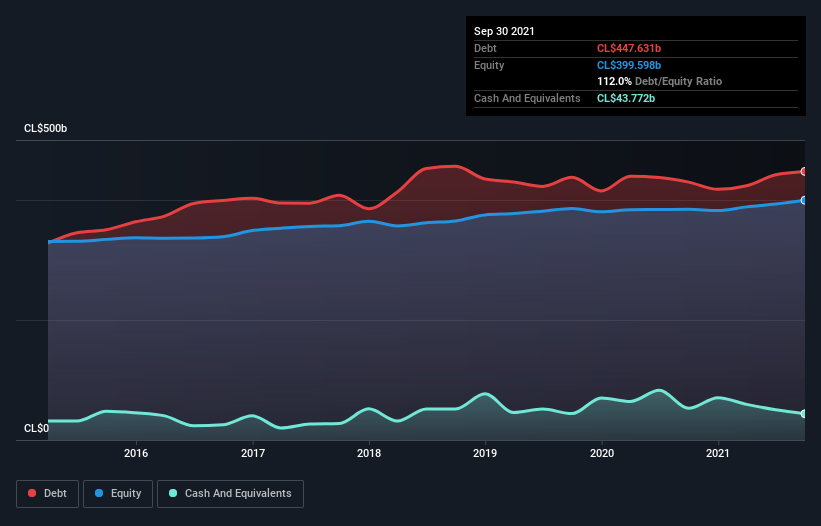
Legendary fund manager Li Lu (who Charlie Munger backed) once said, 'The biggest investment risk is not the volatility of prices, but whether you will suffer a permanent loss of capital.' So it seems the smart money knows that debt - which is usually involved in bankruptcies - is a very important factor, when you assess how risky a company is. Importantly, SalfaCorp S.A. (SNSE:SALFACORP) does carry debt. But should shareholders be worried about its use of debt?
Why Does Debt Bring Risk?
Debt and other liabilities become risky for a business when it cannot easily fulfill those obligations, either with free cash flow or by raising capital at an attractive price. Ultimately, if the company can't fulfill its legal obligations to repay debt, shareholders could walk away with nothing. However, a more usual (but still expensive) situation is where a company must dilute shareholders at a cheap share price simply to get debt under control. Having said that, the most common situation is where a company manages its debt reasonably well - and to its own advantage. When we examine debt levels, we first consider both cash and debt levels, together.
View our latest analysis for SalfaCorp
What Is SalfaCorp's Debt?
The image below, which you can click on for greater detail, shows that at September 2021 SalfaCorp had debt of CL$447.6b, up from CL$429.8b in one year. However, because it has a cash reserve of CL$43.8b, its net debt is less, at about CL$403.9b.

How Strong Is SalfaCorp's Balance Sheet?
According to the last reported balance sheet, SalfaCorp had liabilities of CL$458.9b due within 12 months, and liabilities of CL$327.2b due beyond 12 months. On the other hand, it had cash of CL$43.8b and CL$268.7b worth of receivables due within a year. So its liabilities total CL$473.7b more than the combination of its cash and short-term receivables.
This deficit casts a shadow over the CL$135.0b company, like a colossus towering over mere mortals. So we'd watch its balance sheet closely, without a doubt. After all, SalfaCorp would likely require a major re-capitalisation if it had to pay its creditors today.
We measure a company's debt load relative to its earnings power by looking at its net debt divided by its earnings before interest, tax, depreciation, and amortization (EBITDA) and by calculating how easily its earnings before interest and tax (EBIT) cover its interest expense (interest cover). Thus we consider debt relative to earnings both with and without depreciation and amortization expenses.
With a net debt to EBITDA ratio of 10.9, it's fair to say SalfaCorp does have a significant amount of debt. But the good news is that it boasts fairly comforting interest cover of 4.2 times, suggesting it can responsibly service its obligations. Looking on the bright side, SalfaCorp boosted its EBIT by a silky 79% in the last year. Like the milk of human kindness that sort of growth increases resilience, making the company more capable of managing debt. When analysing debt levels, the balance sheet is the obvious place to start. But ultimately the future profitability of the business will decide if SalfaCorp can strengthen its balance sheet over time. So if you want to see what the professionals think, you might find this free report on analyst profit forecasts to be interesting.
Finally, a business needs free cash flow to pay off debt; accounting profits just don't cut it. So we clearly need to look at whether that EBIT is leading to corresponding free cash flow. Over the last three years, SalfaCorp actually produced more free cash flow than EBIT. That sort of strong cash generation warms our hearts like a puppy in a bumblebee suit.
Our View
While SalfaCorp's level of total liabilities has us nervous. To wit both its conversion of EBIT to free cash flow and EBIT growth rate were encouraging signs. Taking the abovementioned factors together we do think SalfaCorp's debt poses some risks to the business. While that debt can boost returns, we think the company has enough leverage now. When analysing debt levels, the balance sheet is the obvious place to start. However, not all investment risk resides within the balance sheet - far from it. Be aware that SalfaCorp is showing 3 warning signs in our investment analysis , and 2 of those are a bit concerning...
If, after all that, you're more interested in a fast growing company with a rock-solid balance sheet, then check out our list of net cash growth stocks without delay.
New: Manage All Your Stock Portfolios in One Place
We've created the ultimate portfolio companion for stock investors, and it's free.
• Connect an unlimited number of Portfolios and see your total in one currency
• Be alerted to new Warning Signs or Risks via email or mobile
• Track the Fair Value of your stocks
Have feedback on this article? Concerned about the content? Get in touch with us directly. Alternatively, email editorial-team (at) simplywallst.com.
This article by Simply Wall St is general in nature. We provide commentary based on historical data and analyst forecasts only using an unbiased methodology and our articles are not intended to be financial advice. It does not constitute a recommendation to buy or sell any stock, and does not take account of your objectives, or your financial situation. We aim to bring you long-term focused analysis driven by fundamental data. Note that our analysis may not factor in the latest price-sensitive company announcements or qualitative material. Simply Wall St has no position in any stocks mentioned.
About SNSE:SALFACORP
SalfaCorp
Engages in engineering, construction, and real estate businesses in Chile and internationally.
Average dividend payer with mediocre balance sheet.


